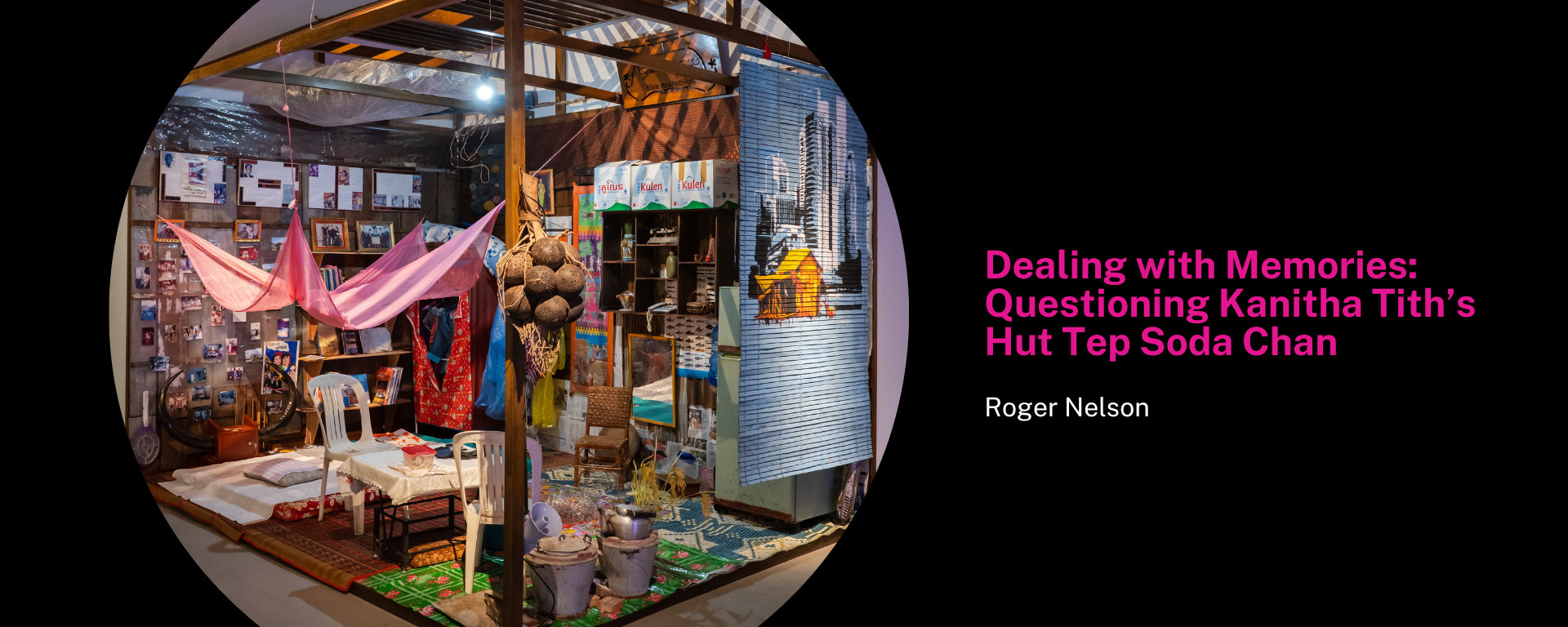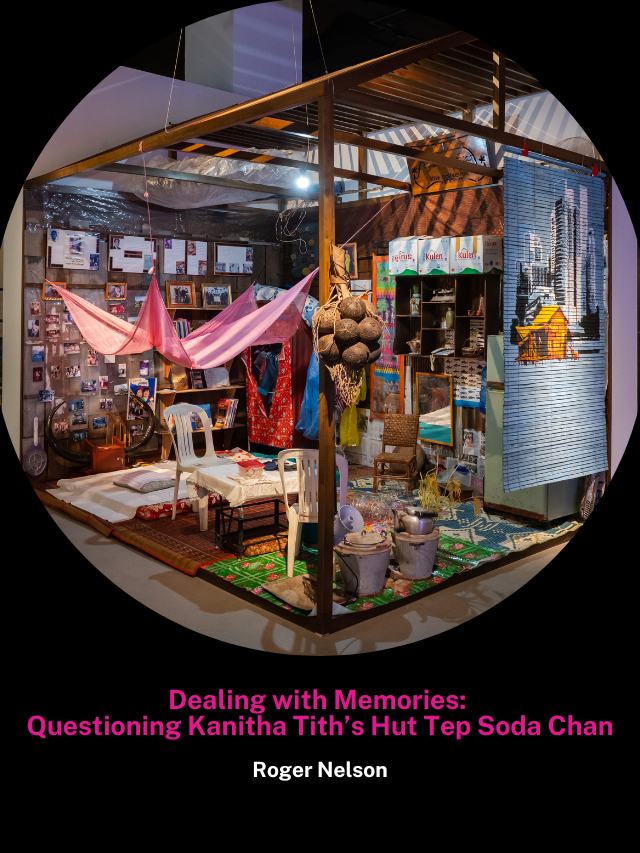Dealing with Memories:
Questioning Kanitha Tith’s
Hut Tep Soda Chan
12 Jun 2023
Hut Tep Soda Chan is an installation comprising objects salvaged from the artist Kanitha Tith’s former home and studio in Phnom Penh. Could the abundant, almost exuberant accumulation of stuff — perhaps things embodying memories? — in this artwork be a means for the artist to (as she says) “untangle all the questions” that she has? She says that she likes to think about memory in an open way: is that what’s happening here? Could the nostalgia in the work have a kind of magical power? Writing of Kanitha’s work in 2022, the curator and scholar Vera Mey notes that “[t]here is a belief in Khmer culture that naming and saying something out loud is like summoning something into existence.” Isn’t this a belief shared widely in many Southeast Asian cultures? Couldn’t the fear of summoning something fearful — a ghost, a tiger — by naming it, also contribute to its inverse, a hope that by speaking of a happy memory, it might be brought into a new or renewed existence? Taking its cue from Kanitha’s habitual curiosity and questioning, this essay follows the artist in asking, “what if, or what if or what if?”
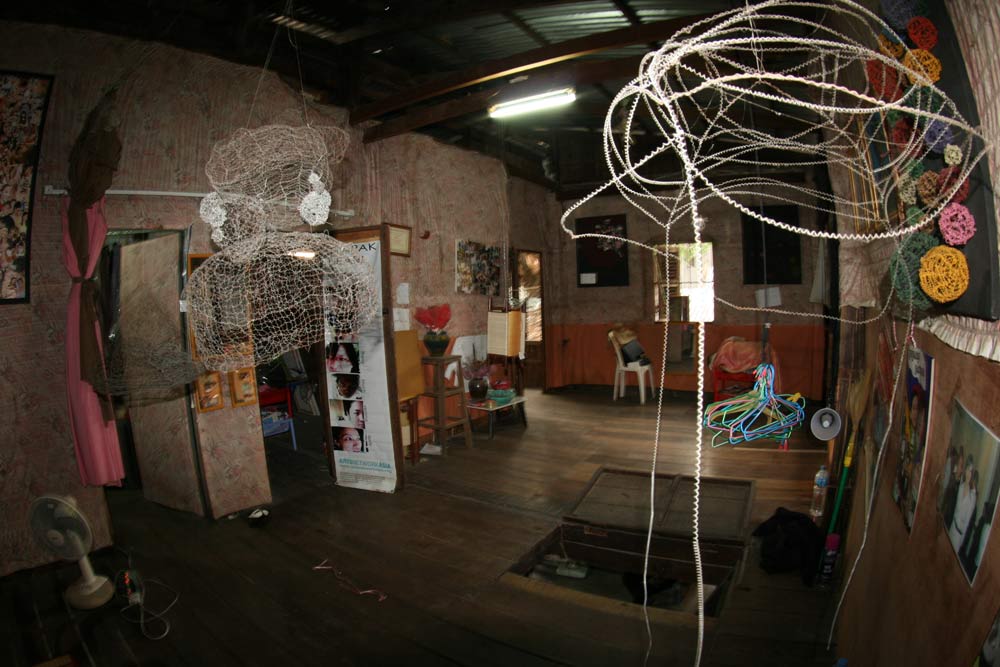
“I’m doing this work,” Kanitha said in 2017, while sitting inside Hut Tep Soda Chan, “because I feel that [there are] a lot of things that I don’t know about my area […] I want to do this work because I want to talk also about what used to happen in that area, but also, dealing with everything that is dealing with the memory.”1 But what kinds of memory, and what kinds of dealing with?
What is Hut Tep Soda Chan? Its namesake, Tep Soda Chan is a 1968 film directed by Lay Nguon Heng that tells the story of — never mind the story — that features in its soundtrack some of the most exhilarating songs by Sinn Sisamouth and Ros Sereysothea, the atmosphere of which permeates Kanitha’s artwork. But what is this hut-as-artwork, mysteriously named after the film, this Hut Tep Soda Chan?
One answer might be that it’s an artwork that’s somehow “about” the infamous forced eviction of thousands of families — including Kanitha’s own family — from the neighbourhood bordering Boeung Kak Lake in central Phnom Penh. Once a flourishing community and a picturesque body of water, the lake has now been completely filled in with sand, in order to make way for private real estate development. Kanitha’s Hut Tep Soda Chan, like the Untitled series of photographs and videos by her peer, the artist Khvay Samnang (and several artworks by other artists too), responds to this human and ecological catastrophe.2
But we weren’t asking what the artwork is about, were we? We were asking what it actually is, weren’t we? Shall we take a cue from Kanitha herself — who is, as we will see, always curious and questioning — and return to that question and ask some more questions of the work?
Perhaps we can say that it’s an installation, but knowing that for a decade and more Kanitha Tith has primarily made objects with coiled wire — objects that are typically called sculptures — we may ask, then, what is it that makes Hut Tep Soda Chan an installation, and not a sculpture? Is it that the installation comprises so many parts? (How many parts? I bet the accessioning staff and conservators could tell us, but would we dare to ask them?) But many of Kanitha’s sculptures are also made from many parts, or rather, many pieces of wire, that are loosely or tightly woven together to form a single artwork; so, is it the absence of this weaving and stitching together — at least, physical and tangible weaving and stitching together — that disqualifies Hut Tep Soda Chan from the status of sculpture — the fact that its parts are only arranged or installed together, but actually remain separate? Or is it that the work is an environment that invites us in, to lounge on the bed, perhaps to take a nap, to browse through the publications, to generally imbibe the vibe? Or is it in the scale of the work, and its legibility as a work of “contemporary art” that suggests installation as the appropriate descriptor for the work?
Should we think of this artwork in relation to the claim that installation is “the leading form in contemporary art”?3 Or perhaps we should approach and inhabit this hut-as-installation emboldened with the scholar Patrick D. Flores’ invocation of the artist-curator Raymundo Albano’s affirmation that “installation” might be imagined as a connective tissue between, to quote Flores quoting Albano, “‘childhood urges’ and an ‘open-mindedness in expressing new sculpture’”?4 After all, didn’t Kanitha live in this hut, this Hut Tep Soda Chan, as a child? Doesn’t her “dealing with the memory” necessitate a certain kind of yielding to what Albano called “urges”?
Or should we think of the artwork not so much as an installation but as a place for gathering, for togetherness? Isn’t that what a home is, even if the home is a hut? And would we be surprised to hear from the artist that this was how the artwork began, too: as a place for gathering, and for screening an old film? Shall we hear about the origins of Hut Tep Soda Chan from Kanitha herself?
In 2010, I was approached by Lydia Parusol to join the project SurVivArt – Art For the Right to a “Good Life”, supported by Heinrich Böll Stiftung (The Green Political Foundation). I was invited together with two other artists from Cambodia, Neak Sophal and Sokuntevy Oeur.
It was my first time to work and engage with the community. I chose to work with five families from my neighbourhood [at Boeung Kak Lake]. I began the project by screening an old Cambodian film from 1968, called Tep Soda Chan. I got inspiration from helping with research about Khmer cinema from the 60s–70s with the filmmaker Davy Chou — and also from my fascination with how my neighbours were using old and broken daily life objects in such a sustainable way. I wanted to merge the belongings from their houses into my parents’ house, representing the memories of a life that will never be the same.
I’m sad not to know all my neighbours’ names because some of them have moved out from my neighbourhood already. But I will try to figure that out later. I also wish to acknowledge and thank some friends of mine and people who were involved with and helped on the project, such as Kong Vollak, Heng Ravuth, Theo Valier, Kate O’Hara, Valia Carvaho, Tith Veasna, Tith Narith and Davy Chou.
After its first exhibition inside my family home, in 2012, Hut Tep Soda Chan travelled to Berlin as part of a group show with other artists from Ethiopia, Nigeria, Cambodia, Myanmar, Thailand and the Czech Republic, at the Mikael Andersen and Meinblau galleries in Berlin.5
And then in 2017, the work was shown again as part of SUNSHOWER: Contemporary Art from Southeast Asia 1980s to Now at the Mori Museum in Tokyo.
Does this clarify matters for us? Is the hut-as-artwork an installation or a site for a screening? Or is it just a hut? Or are we beginning with the wrong questions?
Perhaps the labelling descriptor (“installation” or “sculpture”) doesn’t or shouldn’t matter so much, or perhaps it’s distracting us from thinking about just what makes the work feel so contemporary? After all, isn’t the work also, really, just a bunch of old stuff? This is stuff that appears old not only in a place like Singapore, where people typically update their appliances and décor quite frequently, but even in Cambodia… right? There, a home like this, made with old planks of wood for its walls, would probably be called puran, a lovely Indic word (borrowed from the Sanskrit purāṇa) that may be translated as old, ancient, classical, traditional, old-fashioned — and aren’t these the opposite of contemporary? And isn’t that sense of the puran amplified by the title of the work, since it is named after a classic (or puran) 1960s film, one that is especially precious in Cambodia, where only about 40 films from before the genocide of the 1970s survive?6
Perhaps we could call this loving reference to the so-called “Golden Age” of Cambodia in the 1960s a kind of nostalgia, but surely that’s not even close to being a powerful enough word to describe the depth of longing, the heaping of associations and connotations, the sheer force of the desire and demand to celebrate cultural connections with the (pre-genocide) past, is it? But how else to describe this fascination with, treasuring of and honouring of the artistic and cultural artefacts of the decades that mark the period after independence from colonial rule, and before the genocide? How else to make sense of the reverential historical consciousness manifest in Hut Tep Soda Chan if not to call it nostalgia? Perhaps we need to think of a more active term?
Or perhaps nostalgia is already a vital, vigorous, life-affirming force in the face of the “heavy rock [that] will weigh down on us for many hundreds of years to come.” Isn’t that how the choreographer, researcher and cultural official, Chheng Phon, characterised the legacy of the genocide, in his text from 1983, written just four years after the fall of the Khmer Rouge? Didn’t he lament “the residue, the terrible and terrifying consequences,” declaring without hesitation that “these abominable traces will be truly impossible to forget for the people of all the nations in this world”?7 Echoing (probably unwittingly) the scholar Theodor Adorno’s famed 1949 essay about the impossibility of “poetry after Auschwitz,” Chheng Phon lamented that “[t]here is a limit to the words of humans, there is a border containing that which we can say. We cannot speak at all, we cannot describe a suffering that has no boundary, that is limitless.”8 When I shared these words with Kanitha in a 2022 interview, how did she respond? Shall I quote her at length? And we can see how her curiosity and questioning has guided and inspired this piece of writing?
I don’t think that I can speak directly about the war, either in words or in my work. But sometimes during the process of coiling, many questions come up, and I just try to think what if, or what if or what if?
My experiences, as part of the generation born after the war, are not the same as those my parents have. The legacy of trauma is far from my own, but the sense is still there, like Chheng Phon said, that “We cannot speak at all.”
[…]
The process of coiling wire has become a key that I use to try to untangle all the questions that I have — about my existence, the war, human relationships, politics — and this makes it possible for me to move into abstraction, which has become the core of my practice. I feel that I don't own the “abstract” as a word, and/ or its meanings, or the history of where it comes from. But I can own abstraction in my own experiences and in the love that I have for it. And through feelings that remain from one generation to another, from past to present and to the future, from time to space and from space to time.9
Devoid of the coiled wire found in her sculptures, could the abundant, almost exuberant accumulation of stuff — perhaps things embodying memories? — in Hut Tep Soda Chan be another process for Kanitha to “untangle all the questions” that she has? She has also told me several times that she likes to think about memory in an open way: is that what’s happening here?
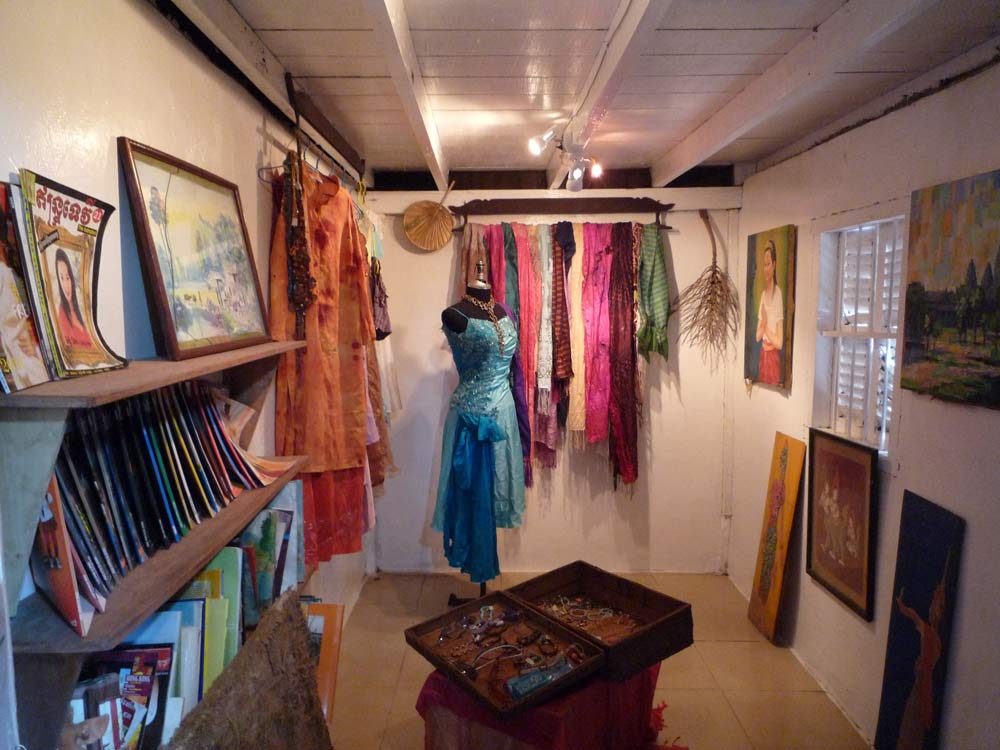
Could the nostalgia in the work have a kind of magical power? Could what Kanitha called “untangl[ing] the questions” and “dealing with the memory” be a way of not only honouring the past, but also of conjuring the dead to be with us here among the living? Writing of Kanitha’s work in 2022, the curator and scholar Vera Mey notes that “[t]here is a belief in Khmer culture that naming and saying something out loud is like summoning something into existence.”10 Isn’t this a belief shared widely in many Southeast Asian cultures? Couldn’t the fear of summoning something fearful — a ghost, a tiger — by naming it, also contribute to its inverse, a hope that by speaking of a happy memory, it might be brought into a new or renewed existence?
But weren’t we thinking about what makes the work feel so contemporary? Isn’t that rather different, perhaps almost the opposite, to thinking about how to articulate the work’s qualities of not-quite-but-more-than nostalgia? Or could it be that, in a Cambodian context at least, the loving and languorous fascination with the past — including with art’s histories, the histories of culture and cinema and film and architecture and so on — that this artwork embodies and epitomises is itself a definitively contemporary gesture? After all, isn’t this something Kanitha (an otherwise very unusual, rather singular artist) shares with her peers — this beguilement with bygone days?11 Perhaps this nostalgia is what makes the work so contemporary, in the Cambodian context?
But what about for viewers outside or unfamiliar with that context? What might the bigger and more diverse publics who encountered the work at exhibitions in Berlin and Tokyo and Singapore have made of the work? Might its density — the fullness of the puran old hut with its puran old stuff — have somehow felt somehow quintessentially “Southeast Asian”? Might some viewers have recalled that electrifying text written by the artist Rod Paras-Perez in 1993, with the title Southeast Asian Sense and Sensibility: The Well-Filled Space, The Well-Cut Silence? In that essay, didn’t Paras-Perez write about “the desire to accumulate a number of things, the sheer accretion of objects, and the compulsion to fill space,” suggesting that this “spatial sensibility” also “permeates” the region’s visual art?12
Or might visitors have brought with them more recent comparisons, other installations (are they?) that are also recreations (or would relocations be a better word?) of familiar old environments? Perhaps like Nge Lay’s The Sick Classroom (2013), presented at the Singapore Biennale in 2013, ten years before Hut Tep Soda Chan was shown in the 2022–23 Singapore Biennale called Natasha? Or perhaps like Nguyen Thi Thanh Mai’s Travels (2014–15), first presented in Phnom Penh in 2015, and exhibited again at the Nguyen Art Foundation in Ho Chi Minh City contemporaneously with Natasha’s run?13
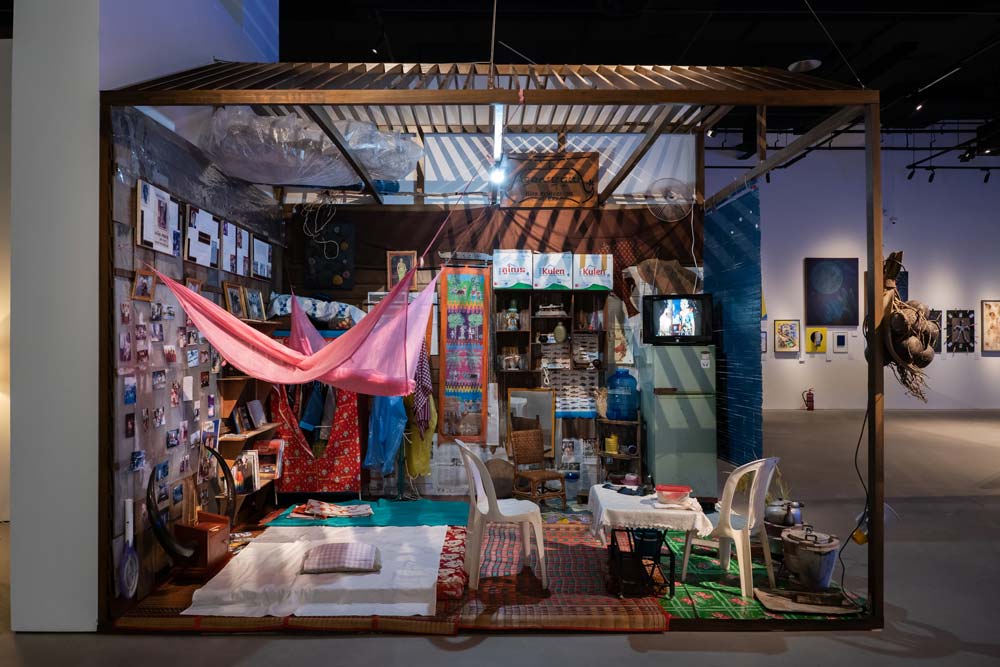
Or might visitors have thought of the elaborate reconstructions of evocatively nostalgic (that word again) interiors in the work of Zineb Sedira, presented in the French Pavilion at the 59th Venice Biennale in 2022, also contemporaneous with Natasha? Sedira’s installation (that word again, too!) combined an explicit theatricality — replete with big cameras on tripods and green screens and stage lights — with a cosily domestic familiarity; might Kanitha’s Hut Tep Soda Chan also have become a somewhat performative space, when shown in the grand spectacle of a large exhibition (even one that professed to shun spectacle, as Natasha’s curators claimed)?14 Napping as theatre? Poverty porn?
Insofar as Hut Tep Soda Chan provides a (literal and physical, as well as imaginary) space for gathering and being, mightn’t the installation be constellated with other artworks that have — in the words of Flores, again — “paved the way for a particular mode to make sense of relationality in Southeast Asia”?15 Flores observes that, for artists such as Moelyono and David Medalla, “locality and migrancy” go together — both artists “manifested in their work the desire to go inward into the village as well as outward into exile”16 — so might Kanitha’s homey hut that travelled to Germany and Japan and Singapore offer a similar space that is both rooted and roving? Perhaps this relationality, when overlaid with nostalgia, might also be part of makes the work so contemporary?
And what of the private joys and sorrows that might lurk in the shadows of the work? Shall we dedicate this piece of writing to the artist’s late mother, and to her newborn son? After all, before it was an artwork, Hut Tep Soda Chan was a home, for the artist and her family — and surely that means something, and does something to its power over us and our experience of the work?
But perhaps we might also wonder about the relationship between Hut Tep Soda Chan and the artist’s most recent works? As well as continuing to make the coiled-wire sculptures for which she is best known, since 2021, hasn’t Kanitha also begun to make “drawings” using watercolour paint that she often applies using her sculptures? The sculptures and the drawings seem to eschew figuration, yet Hut Tep Soda Chan is surely a representation of the artist’s former home — so how could one artist, one mind, have created such disparate works? How does this work, this installation, started in 2011, near the beginning of Kanitha’s practice, relate to the latest turn in her work, her sudden embrace in 2021 of what she insists on calling “drawing,” even if it is made with paint?
And for some questions, for some memories, for some mysteries: we will just have to wait and see.
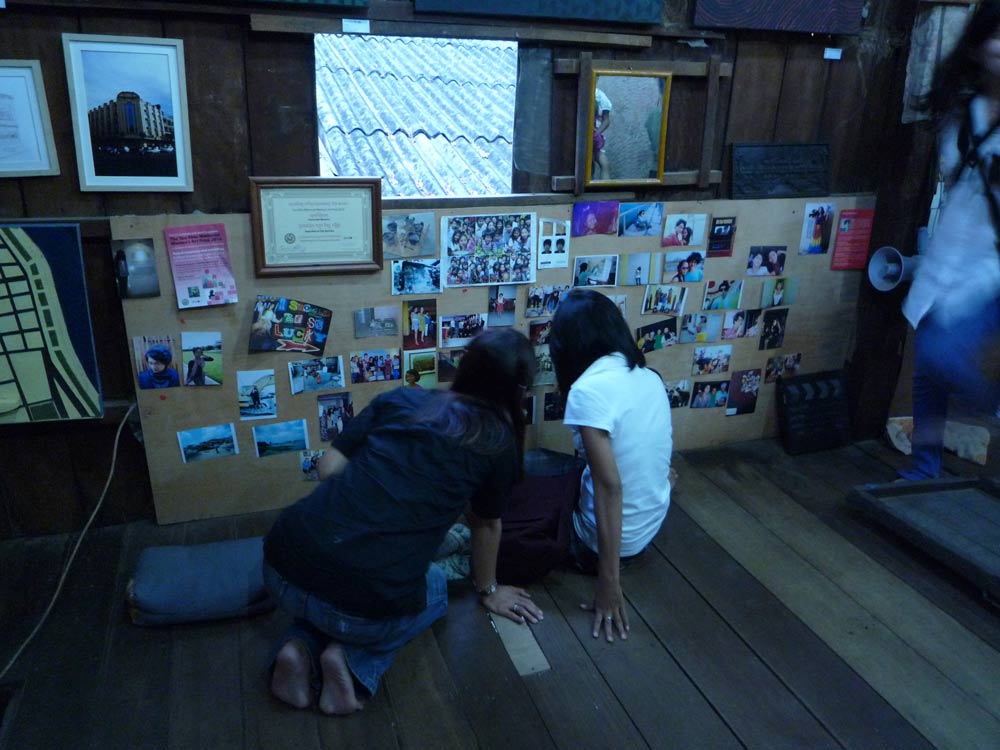
Artist Bio
Kanitha Tith (b. 1987) is a cross-disciplinary artist working between the visual arts in sculpture, performance and installation as well as a director and artistic director in Cambodia’s independent film industry. Graduating with a degree in interior design, Tith later shifted to the visual arts after discovering the sense of freedom that comes from using daily objects to construct installations. Her works focus on the personal experiences, collective memory and her surrounding environment. She currently lives and works in Phnom Penh.
Author Bio
Roger Nelson is an art historian and curator, and Assistant Professor of Art History in the School of Humanities at Nanyang Technological University, Singapore. He researches modern and contemporary art in Southeast Asia. Roger was the 2022 recipient of the A.L. Becker Southeast Asian Literature in Translation Prize for his translation of Suon Sorin’s 1961 Khmer novel, A New Sun Rises Over the Old Land. He is co-founding co-editor of Southeast of Now: Directions in Contemporary and Modern Art in Asia, a scholarly journal published by NUS Press.
1. I thank the artist Kanitha Tith for her boundless generosity and infinite inspiration, now and always. I also thank the curators Sohrab Mohebbi and Ryan Inouye for showing her work in a new context (at the 58th Carnegie International, in 2023-23), and thereby sharing with me new ways to think with this work. Thanks also to Khim Ong and Joella Kiu for the generous invitation to write this text.
CoBo Editorial, “Tith Kanitha – Once Upon a Time in a Cambodian Hut,” CoBo, 18 July 2017. https://www.cobosocial.com/dossiers/tith-kanitha-once-upon-a-time-in-a-cambodian-hut/ (accessed March 2023).
2. See: Chloé Baker, “Cambodia Here and Now,” ArtPress, 21 October 2019. https://www.pressreader.com/france/artpress/20191021/283003991586844 (accessed March 2023). See also: Roger Nelson, “Art and Sand in Cambodia: Please Enjoy My Sand!,” Artlink 33, no. 4 (2013): 55-57.
3. Boris Groys, “The Topology of Contemporary Art,” in Antinomies of Art and Culture: Modernity, Postmodernity, Contemporaneity, ed. Terry Smith, Okwui Enwezor and Nancy Condee (Durham: Duke University Press, 2008), p. 74.
4. Patrick D. Flores, “Towards a Lexicon of Inclinations: Words Forming Worlds in Southeast Asia,” Asian Diasporic Visual Cultures and the Americas 3 (2017): 41.
5. https://www.boell.de/en/ecology/ecology-society-survivart-art-right-good-life-exhibition-13770.html (accessed March 2023).
6. See the wonderful documentary film about Cambodian cinema histories, directed by Davy Chou titled Golden Slumbers and released in 2011.
7. Chheng Phon, “Views from a Representative of Artists” (1983), trans. Roger Nelson, in The Modern in Southeast Asian Art: A Reader, eds. T.K. Sabapathy and Patrick D. Flores (National Gallery Singapore, 2023), pp. 1165-1168.
8. Chheng Phon, “Views,” p. 1166.
9. Kanitha Tith quoted in Roger Nelson, “Tith Kanitha in Conversation with Roger Nelson,” in Is It Morning For You Yet? The 58th Carnegie International, eds. Michelle Piranio and Karen Jacobson (Pittsburgh: Carnegie Museum of Art, 2022), pp. 184-191.
10. Vera Mey, Someone is Moving: Kanitha Tith (Singapore: Singapore Biennale and Singapore Art Museum, 2022), p. 35.
11. We need think only of Vandy Rattana’s filmic ode to his sister, who died in the genocide (MONOLOGUE, 2015, collection of Singapore Art Museum), or the Vann Molyvann Project’s architectural models that at once study and honour the great tropical modernism of the 1960s (in the collection of National Gallery Singapore), or Khvay Samnang’s Preah Ream Thlaeng Sor, a series of photographs shot with this pre-war architecture as backdrop (https://www.khvaysamnang.com/works/preah-ream-thlaeng-sor/ (accessed March 2023)), to see how pervasive this nostalgia for the so-called “Golden Age” is.
12. Rod Paras-Perez, “South-East Asian Sense and Sensibility: The Well-Filled Space, the Well-Cut Silence,” Art and Asia Pacific 1, no. 4 (1 October 1994): 68.
13. See “No More, Not Yet,” February-June 2023, Nguyen Art Foundation. https://nguyenartfoundation.com/exhibitions/no-more-not-yet/ (accessed March 2023).
14. According to co-Artistic Director, June Yap: “We did make a fairly clear mention in an early media conference that we are not looking to create a Biennale spectacle.” Quoted in Sheryl Gwee, “What’s Up with Natasha?,” Plural, 7 March 2023. https://pluralartmag.com/2023/03/07/whats-up-with-natasha/ (accessed March 2023)
15. Patrick D. Flores, “Actually Existing: Aesthetic Effect and Effective Relations in Southeast Asia,” in The Global Contemporary and the Rise of New Art Worlds, eds. Hans Belting, Andrea Buddensieg and Peter Weibel (Karlsruhe, Cambridge, London: ZKM Center for Art and Media and MIT Press, 2013), p. 276.
16. Flores, “Actually Existing,” p. 273.

